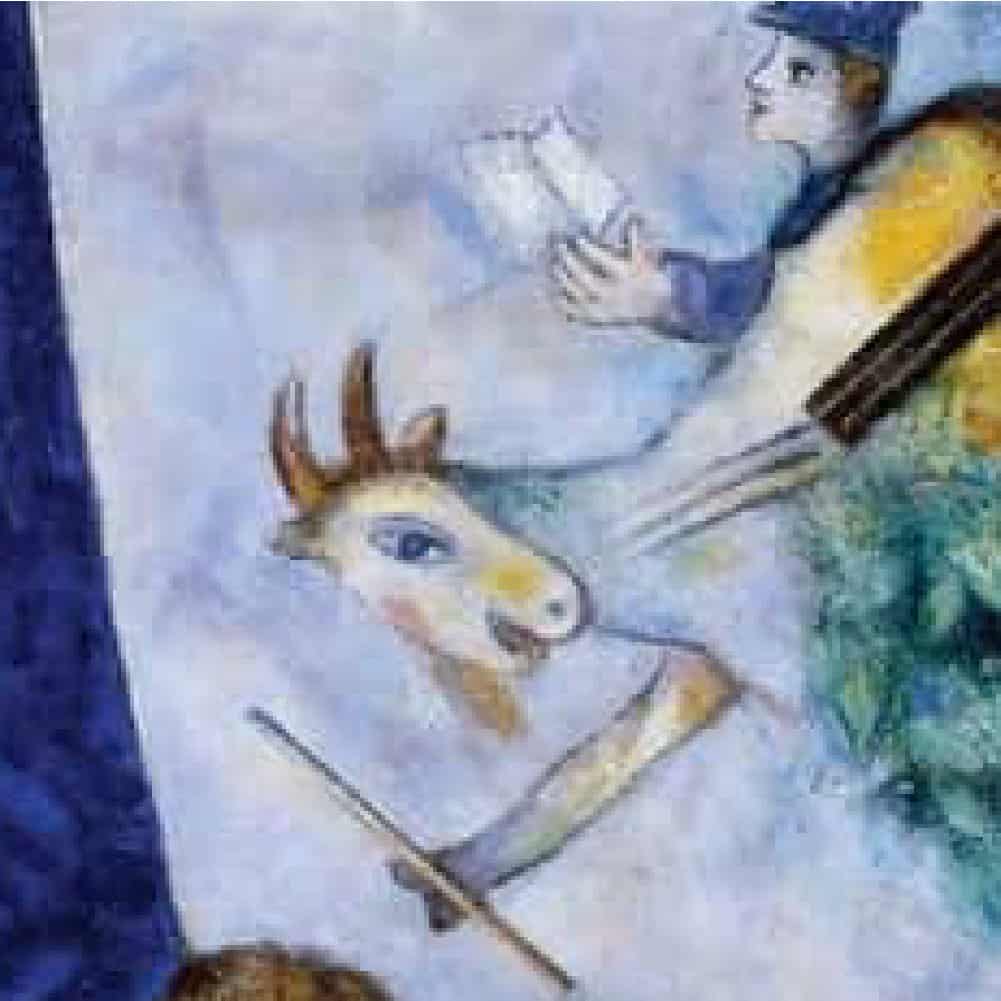What makes Chagall’s art so special?
Ask me, and I’ll tell you that what makes Chagall’s art so special is the rich imaginary world he created through his paintings. Of course, he was an outstanding colorist, but I don’t believe his works would have been as powerful without the incredible set of characters that he created.
His paintings are filled with recurring imagery and landscapes, almost like the characters of a book.
To truly appreciate Chagall’s art, you need to be familiar with these characters, which are deeply personal to the artist. I don’t think it’s a stretch to say that there is no understanding Chagall’s art without understanding Chagall.
Table of content:
Chagall’s characters:
- The Fiddler
- “The Lovers” and “The Bride”
- The circus, the acrobats and the clowns
- The Rooster
- The Goat
Want to know how to animate those characters into a puppet show? Scroll to the end of this page or click here to see how we did it!
Chagall’s symbols explained. Or not.
I often see, especially online, Chagall’s art being “interpreted” through the analysis of so-called “symbols,” referring to the recurring set of characters that appears in his paintings: the rooster, the cow, the bride, the fiddler… After all, most of his art looks straight out of a dream, and it’s very tempting to consider it as a representation of the subconscious mind.
After all, a simple google search for “Chagall’s symbols explained” will give hundreds of thousands of results. Unfortunately, we know by now that “popularly believed” doesn’t necessarily mean “factually correct.” To the disappointment of thousands of art lovers, art historians have pretty much agreed that to interpret Chagall’s imagery as symbols is, at the very least, misleading.
I feel it’s time to add a little disclaimer: it may seem like I enjoy complicating things just for the sake of it. I swear I do not. In my humble experience, it’s not the complexity that scares people off art, but rather the jargon, the abstract rhetoric, the hyperbole that often accompanies it.
My mission, as an art writer and as an art teacher, is to dive into this complexity, unravel it, and make it accessible to students and to laypeople. For instance, to say that Chagall’s rooster is a symbol is not just an oversimplification, it’s factually incorrect, and I would be doing a great disservice. Art is no fast-food: it’s meant to be consumed slowly, with the senses but also with the mind, like a good meal or a nice glass of wine.
So, what is a symbol?
Honestly, it’s hard to say at this point; we talk about “symbols,” “symbolize,” “represent” a whole lot and with very different meanings.
By definition, a symbol it’s a mark or a character used as a conventional representation of an object, function, or process. Simply speaking, a symbol is used as a stand-in for a more broad, general, idea.
The tricky thing with symbols though, it’s that to keep their representative potential, they need to convey the same meaning at least within a given population, epoch, culture or geographic area. In other words, for an image to be a symbol, multiple people have to interpret it the same way even when placed in different contexts.
Moreover, the relationship between symbol and meaning is often a two ways path: the dove is a symbol of peace and peace can be represented with a dove. To believe that bride=Bella, rooster=Chagall, fiddler=jewish culture, is not just misleading, it’s also incredibly limiting to the depth of Chagall’s universe.
Earlier I mentioned the rooster that appears in almost all of his paintings. It is correctly said to be a representation of the artist himself: not a symbol, but more like an avatar or alter ego, an expedient for the painter to be part of the scene without it being a self-portrait. Picasso used a very similar trick in his paintings by identifying with the Minotaur’s character.
Chagall’s paintings may look like they came from a dream, but there is nothing oneiric about them. Even though he’s sometimes considered the grand-father of Surrealism, he refused any association with it, as he never shared any interest in subconscious or automatic art. For For Chagall, his craft was a very deliberate action; there was nothing “casual” about painting.
“They are only pictorial arraignments, which obsess me. The theories that I could make up to explain myself and those that others elaborate regarding my work are nonsense. My painting are my raison d’être, my life, and that is all there is to say. “
In conclusion, the reasons why I don’t think it’s correct to talk about symbols are:
- The significance of Chagall’s characters develops over time and changes with context.
- Images and meanings do not coincide and cannot be used interchangeably (es. The painter and the rooster).
- The characters’ references come from the personal life of the author, not from common knowledge.
Instead, I came to the conclusion that the most effective way to understand (and to teach) Chagall’s art is to consider his art as a whole, all coexistent within the same fictional world. What I’d like to do, is to draw an analogy between Chagall’s work and that of a writer that creates characters that live, grow, and interact within the same narrative universe.
What is a narrative universe?
A narrative universe, or storyworld, is a collection of characters and locations linked together to form a cohesive and functional entity – a recognizable, unified structure that can evolve over time.
In literary theory, a successful storyworld comprises seven fundamental parts: location, Epos (cultural background), shared values, language, relationships and hierarchies, aims and objectives, and time.
However, labeling Marc Chagall’s art as a narrative universe makes it easy to categorize him as a storyteller, a title he firmly rejected.
Chagall’s paintings are set in Russia and France, with a cultural background that is clearly rooted in Hasidic Judaism. Sentiments such as joy, love, and melancholy are all present in his works, but what is notably absent is a clear sense of time.
In the traditional sense, a storyteller is someone who recounts a story, real or imaginary, with a defined beginning and conclusion. However, the dreamlike quality of Chagall’s paintings creates an alternative reality where temporal reading, or a chronological account of actions and effects, is impossible.
To borrow from literary terminology, there is no plot to Chagall’s stories, at least not within one frame. However, his paintings are far from static, and each character has a rich backstory that contributes to a sense of historical depth. For example, the fiddler embodies childhood memories of the Shtetl and the joyful spirit of the Hasidic Jews. The bride is forever intertwined with Chagall’s love for Bella, his first youthful love. These characters existed in real life and in tradition before they were ever painted.
To paint a dreamscape.
In my opinion, the richness and depth of Chagall’s characters are the most fascinating aspects of his art and the reason why I personally find his work so captivating.
Being in a Chagall painting is like being in a dream, where things are just slightly different from what we would expect: unrealistic but not abstract, improbable but not impossible, realistic but not rational. It is in these dreamscapes that we encounter the fiddler on the roof, the lovers floating over the city, the acrobats, the clowns, the blue donkeys, and a green horse.
It’s no surprise that Chagall’s paintings have inspired a remarkable number of theatre plays, including “The Fiddler on the Roof” and “The Flying Lovers of Vitebsk.” Chagall himself was passionate about the theatre and worked on numerous productions.
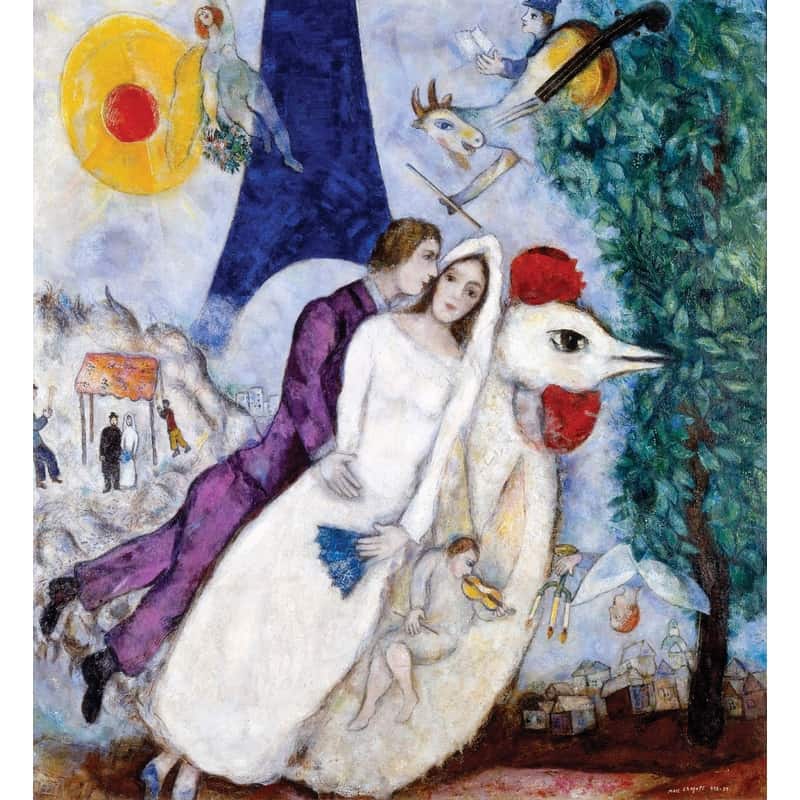
Introducing Chagall’s characters
Fiddler
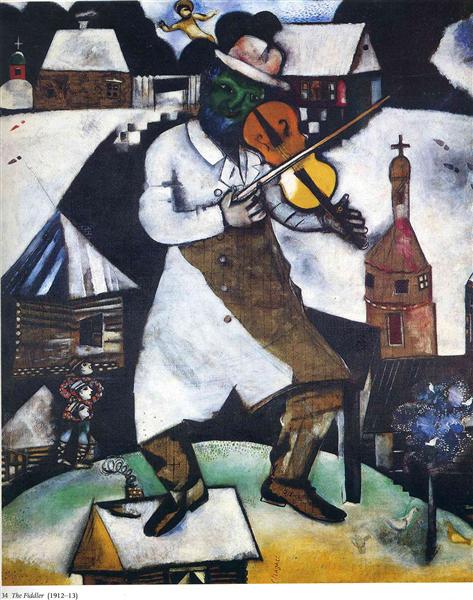
Chagall was born in Vitebsk, a small town in modern day Belarus that was home to a large community of Hasidic Jews.
Hasidic Judaism is a spiritual revival movement that originated in Western Ukraine in the 18th century and is closely connected to Orthodox Jews and the Yiddish culture of Eastern Europe. One of the peculiarities of this faith is the belief that communion with God can be achieved through joy and happiness. As a result, musicians played a fundamental role in the life of the village, celebrating God with their music and dance.
Chagall’s Uncle Neuch, a cattle dealer who played the violin at festivals and celebrations, was one of his favorite relatives. Despite “playing the violin like a shoemaker,” young Chagall was captivated by his uncle’s dancing and music. As he remembers, watching Neuch play would fill him with so much joy that his head would float away from his body and follow his uncle.
The violinist, a reference to his childhood and to the joyful life of the Jewish shtetl, became one of the most iconic images in Chagall’s repertoire. Some of his most famous paintings, such as “A Violinist” from 1912-1913 and “A Violinist and an Inverted World” from 1929, depict a fiddler floating above the roofs. This image even served as inspiration for the name and stage design of the Broadway musical “Fiddler on the Roof.”
Related artworks: “The Deceased,” “The Fiddler“1914, “The Blue Fiddler.”
“The Lovers” and “The Bride”
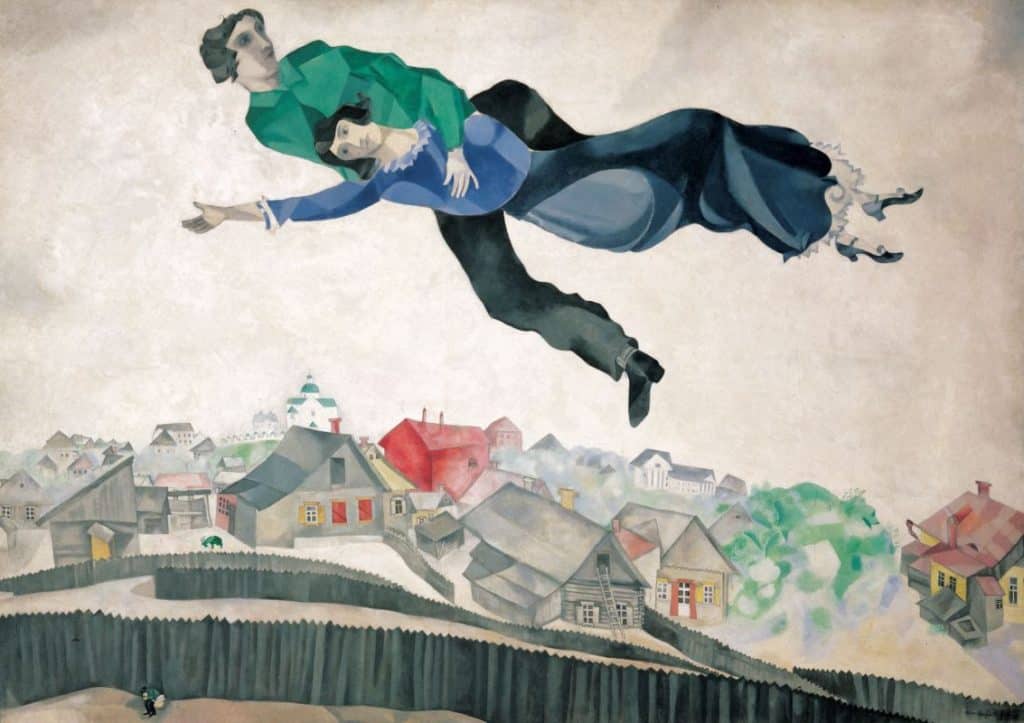
Chagall met Bella Rosenfeld in 1910 during a brief visit home, and the two fell in love immediately. Even though he had moved to Paris to pursue his artistic career, they remained lovers until 1915, when Chagall decided to travel back to Vitebsk to marry her.
He had planned to be in Russia for only a short period when the First World War began. Unable to leave Russia and separated from all of his paintings, Chagall moved with Bella to St. Petersburg, where their daughter Ida was born a year later.
Despite the war and the upcoming Russian revolution, the paintings of this period, which show the young couple floating in love over Vitebsk, are some of the most euphoric and lighthearted of his career.
Marc, Bella, and Ida traveled as a passionate trio through Europe as history unfolded. They were in Russia during World War I and the communist revolution, then back to Paris until World War II. Ultimately, they fled to New York to escape the Holocaust. Unfortunately, just weeks before the couple was to return to France in 1944, Bella suddenly died of a viral infection.
Deeply shaken by the sudden loss, Chagall stopped painting for a year.
Chagall had started “The Bride and Groom on Cock” in 1939 while in Paris with his wife and daughter. It would finally be completed almost a decade later, in 1947, by an older and very changed Chagall: a widower returning to France after six years in the States with a new partner, Virginia Haggard McNeil, and a newborn son, David.
In the years following Bella’s death, Chagall became even more devoted to these themes, making “The Lovers” and “The Bride” some of the most recurring sets of characters.
Related artworks: “The Bride,” “The Promenade,” “Blue Lovers.”
The circus, the acrobats and the clowns

In 1966, Chagall wrote:
“These clowns, bareback riders and acrobats have made themselves at home in my visions. Why? Why am I so touched by their make-up and their grimaces? With them, I can move towards new horizons.”
Starting in 1926, Chagall’s friend Vallard frequently invited him to his private box at the Cirque d’Hiver (the Winter Circus) in Paris. This was the same venue where Henri de Toulouse-Lautrec and Georges Seurat painted their famous circus drawings. During this time, Chagall completed what came to be known as the ‘Cirque Vollard’ series.
Like many other artists of the time, Chagall was incredibly fascinated by the circus and its acrobats: the extravagant spectacle of outcasts, the colors, the exaggerated drama and comedy. T
he farce and make-believe nature of it resonated with the Parisian artists, who identified with the acrobats living at the edge of society.
Related artworks: “Three Acrobats,” “The Acrobat.”
The Rooster

The rooster has been a beloved subject of artists for centuries, but for Marc Chagall, it held a special significance that went beyond its visual appeal. Painted in a multitude of colors, the rooster occupies a unique place in Chagall’s personal mythology, reminiscent of his childhood in the village.
In many ways, it serves as a non-human projection of the artist himself in his paintings, a personal avatar of Chagall on the canvas.
The rooster appears in various forms throughout Chagall’s works, often paired with lovers, sometimes as the subject, and other times hidden in a corner. But it is always present, a constant reminder of Chagall’s roots and the rural world that he left behind.
“The Rooster” from 1929 is a standout example of Chagall’s fascination with the bird, but it is far from the only one. Other notable works include: “The Rooster” 1929, “The Juggler,” “Listening to the Cock,” “A Rooster.”
The Goat
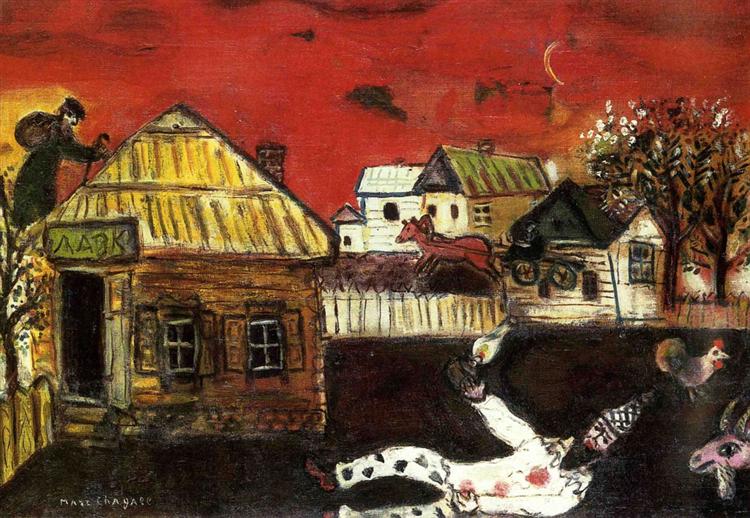
Marc Chagall’s artistic vision is imbued with references to his Jewish heritage and his childhood memories in the village of Vitebsk.
One of the recurring elements in his works is the goat, a figure that evokes both religious significance and personal nostalgia.
In Chagall’s painting “Corbeille de fruits” from 1980, a goat can be seen in the background. This is not a coincidence, as the goat has a special role in Jewish folklore. On the Day of Atonement, a red ribbon is tied around the goat’s neck to symbolize the people’s sins, and the animal is then released into the wilderness to expiate them.
Beyond its religious connotations, the goat also represents Chagall’s connection to the rural life of his childhood. Along with other farm animals like the rooster, the horse, the donkey, and the cow, the goat was a familiar sight in Vitebsk.
In works like “A Village in Winter” and “Spring,” the goat serves as a reminder of the simple joys of rural life, the harmony between humans and nature, and the spiritual values that underpin Chagall’s worldview. As such, the goat is not just a passive subject in Chagall’s art, but an active agent of meaning and emotion.
Related artworks: “A Village in Winter,” “Spring.”
You might also like:
Would love to hear what you think! Share your thoughts in the comments below!

